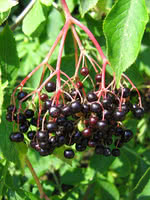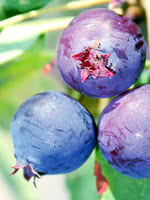Mon-Fri 9am - 5pm Mountain time
Martin Saskatoon (Serviceberry) vs Black Elderberry
Sambucus canadensis
Amelanchier alnifolia Martin
NOT AVAILABLE THIS SEASON - MIGHT RETURN
Black Elderberry is a deciduous shrub native to eastern North America. You can plant this shrub in moist areas and it will help stabilize your soil. You can also use it on rural properties anywhere you'd use a lilac.
Black Elderberries are considered to be partially self-pollinating. So while they will still produce some berries without cross-pollination, planting with another variety will increase yields. Consider planting with Ranch Elderberry or Bob Gordon Elderberry.
Warning: the seeds, stems, leaves, roots, and uncooked berries of the Black Elderberry are poisonous to humans when eaten in quantity. You should cook the berries to make them safe for human consumption.
Martin Saskatoon is a prairie hardy shrub. The berries have a large size and a delicious taste. This species has consistent yield, making it great for both orchards and small gardens. The berries ripen uniformly, making them convenient for machine harvesting.
Black Elderberry Quick Facts
Martin Saskatoon (Serviceberry) Quick Facts
Toxicity: leaves, stems, and uncooked berries are poisonous to humans

